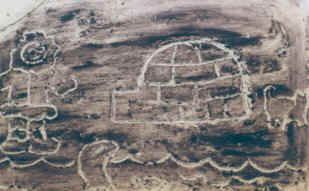Inuit People
Diet and Agriculture
The walrus, seal, and other fur-bearing sea mammals supply food and clothing to the Inuit. All parts of the animals were used. Parkas were made of sealskin. The walrus hide was made into boats. In the winter, seals were harpooned at their breathing holes in the ice. A hunter might have to stand still for hours waiting for the seal to come up for air. In the summer, the seals came out of the water to sun themselves. The hunter could crawl close to the seal and throw a harpoon to kill it. In late summer, the caribou were hunted. Inuit hunters made camp near the caribou grazing grounds. They would ambush the slow-moving herd with bows and arrows.

Drawing of an Inuit Hunter
Cultural Practices
The Arctic Indigenous peoples are closely connected to nature. Their tradition believes every being has a spirit and must be treated respectfully.
Tools, Weapons, and Utensils
Umiaks were large open boats. Kayaks were light canoes made by stretching skins over a wooden framework. The Inuit used several kinds of harpoons and spears. Large harpoons were used to hunt the walrus, while smaller spears were for hunting small animals and birds. Wooden spear throwers were used to increase the spear’s power. All spear throwers were individually made for the hunter, with the length of the thrower equal to the distance between the hunter’s forefinger and his elbow. Dog sleds were a vital means of transportation in the harsh Arctic environment.

Drawing of a Man with a Dog Sled
Art and Craftsmanship
Inuit artists created simple depictions of animals, birds, and daily life scenes, often appliquéd onto caribou and sealskin. Stone sculptures of animals like the wolf, polar bear, birds, reindeer, and walrus were common. Scrimshaw was a famous technique used by the Inuit, involving the engraving of pictures that told stories in ivory, which were then rubbed with lampblack.

Student Craft Project of Scrimshaw